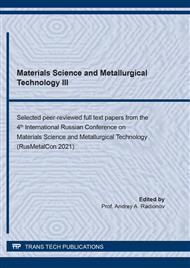[1]
S. Karagöz, Ş. H. Atarek, R. Adali, Ş. Polat, Microstructural characterization of high chromium added cast iron and the relationship of microstructure-wear, Metal World. 183 (2008) -104.
Google Scholar
[2]
J.R. Davis (Eds.), Metallurgy and properties of high alloy white irons, ASM Specialty Handbook Cast Irons, Materials Park, OH: ASM International, (1996).
Google Scholar
[3]
N.V. Koptseva, M.V. Chukin, O.A. Nikitenko, Use of the Thixomet pro software for quantitative analysis of the ultrafine-grain structure of low- and medium-carbon steels subjected to equal channel angular pressing, Metal Science and Heat Treatment. 7-8 (2012) 387-392.
DOI: 10.1007/s11041-012-9518-z
Google Scholar
[4]
I.H. Tuhvatullin, Modeling and development of compositions of casting wear-resistant steels by means of neural network method: Abstract of PhD in Engineering thesis, MISiS, Moscow, (2002).
Google Scholar
[5]
V.M. Sadovsky, O.S. Komarov, S.N. Gertsik, et al. Influence of carbon and chromium content on the properties of high-chromium cast iron, Casting Production. 5 (1998) 12-13.
Google Scholar
[6]
I.I. Tsypin, White wear-resistant cast irons Structure and Properties, Metallurgy, Moscow, (1988).
Google Scholar
[7]
Kh. Abdel-Aziz, M. El-Shennawy, O. Adel, Microstructural characteristics and mechanical properties of heat treatment high-Cr white cast iron alloys, International Journal of Applied Engineering Research. 12 (2017) 4675-4686.
Google Scholar
[8]
O.I. Kovalenko, A.A. Mulik, E.Yu. Prokazov, Influence of alloying and heat treatment on the structure and hydroabrasive resistance of chromium-manganese cast iron, Cast Wear-Resistant Materials. (1978) 115-125.
Google Scholar
[9]
V.M. Kolokoltsev, V.V. Bahmetiev, K.N. Vdovin, V.A. Kuts, Abrasive Wear Resistance of Cast Steels and Cast Irons, NMSTU, Magnitogorsk, (1997).
Google Scholar
[10]
V.M. Kolokoltsev, M.G. Potapov, A.V. Mikhailov, et al. Development of a new composition of special cast iron for castings operating in abrasive and impact-abrasive wear conditions, Ferrous Metallurgy. Bulletin of Scientific, Technical and Economic Information. 12 (2017) 70-73.
Google Scholar
[11]
I.I. Tsypin, White wear-resistant cast iron - evolution and prospects, Liteinoe Proizvodstvo. 9 (2000) 15-16.
Google Scholar
[12]
Yu.G. Bobro, Alloyed Cast Iron, Metallurgiya, Moscow, (1976).
Google Scholar
[13]
G.I. Silman, Thermodynamics and Thermokinetics of Structure Forming in Cast Iron and Steels, Mashiniostrornie, Moscow, (2007).
Google Scholar
[14]
A.E. Leikin, B.I. Rodin, Materials Science: Textbook Manual for Mechanical Engineering Specialties of Universities, Higher School, Moscow, (1971).
Google Scholar
[15]
V.M. Kolokoltsev, E.V. Petrochenko, Metallurgical and metal-science aspects of rising the functional properties of white cast iron products, Vestnik Magnitogorskogo Gosudarstvennogo Tekhnicheskogo Universiteta im G. I. Nosova. 4 (48) 2014 87-98.
Google Scholar
[16]
M.E. Garber, Wear-Resistant White Cast Iron: Properties, Structure, Technology, Operation, Mashiniostrornie, Moscow, (2010).
Google Scholar
[17]
B.A. Voinov, Wear-Resistant Alloys and Coatings, Mechanical Engineering, Moscow, (1980).
Google Scholar
[18]
V.M. Kolokoltsev, E.V. Petrochenko, A.V. Mikhailov, Study of the influence of the ratio of carbon and manganese on the structure and properties in Fe - C - Mn alloys; based on materials from the V International Scientific and Practical Conference Engineering Sciences – from Theory to Practice,, Globus, St. Petersburg. 1(3) (2016) 58-65.
Google Scholar
[19]
V.M. Kolokoltsev, A.M. Stolyarov, P.A. Molochkov, et al. Interrelation of chemical composition, mechanical properties and wear resistance of medium-chromium cast irons for section rolling rolls, Bulletin of NMSTU. 3(27) (2009) 15-18.
Google Scholar
[20]
M. Kawalec, Modification of the high-alloyed white cast iron microstructure with magnesium master alloy, Archives of Foundry Engineering. 13(2013) 71-74.
DOI: 10.2478/afe-2013-0039
Google Scholar
[21]
A. Bedolla-Jacuinde, F. V. Guerra, I. Mejı ́, J. Zuno-Silva and M. Rainforth, Abrasive wear of V–Nb–Ti alloyed high-chromium white irons, Wear. 332-333 (2015) 1006-11.
DOI: 10.1016/j.wear.2015.01.049
Google Scholar


